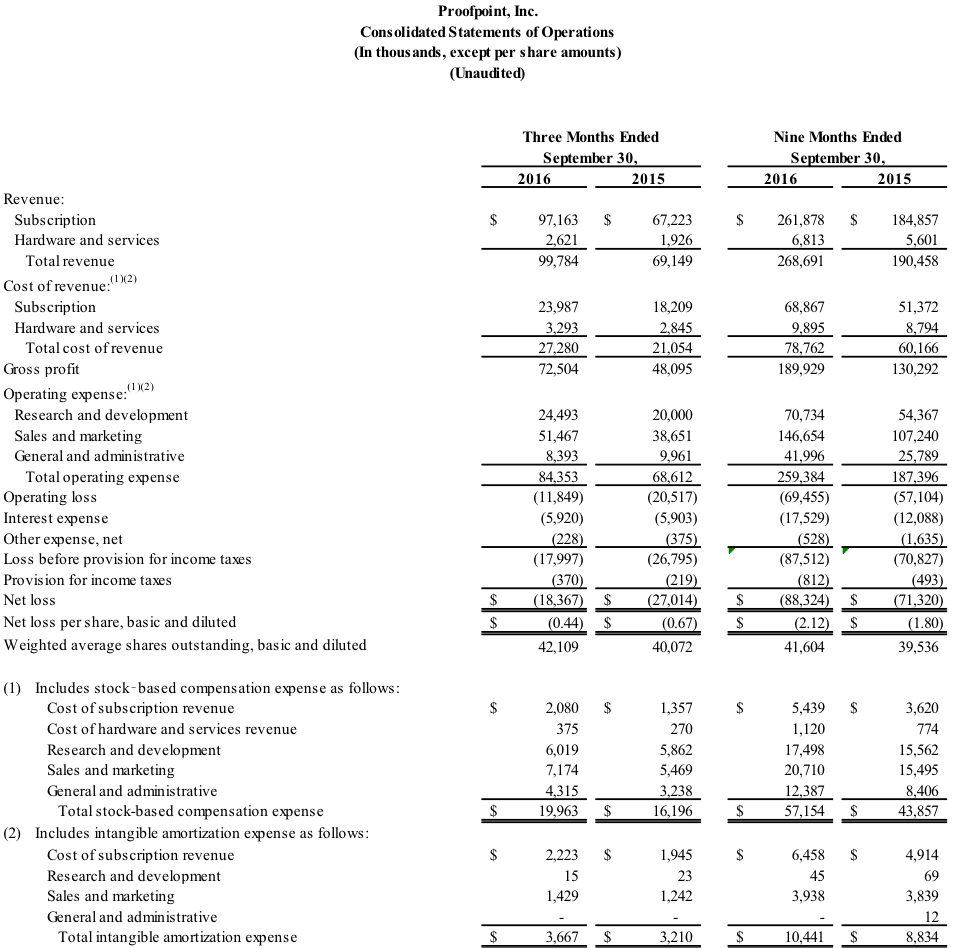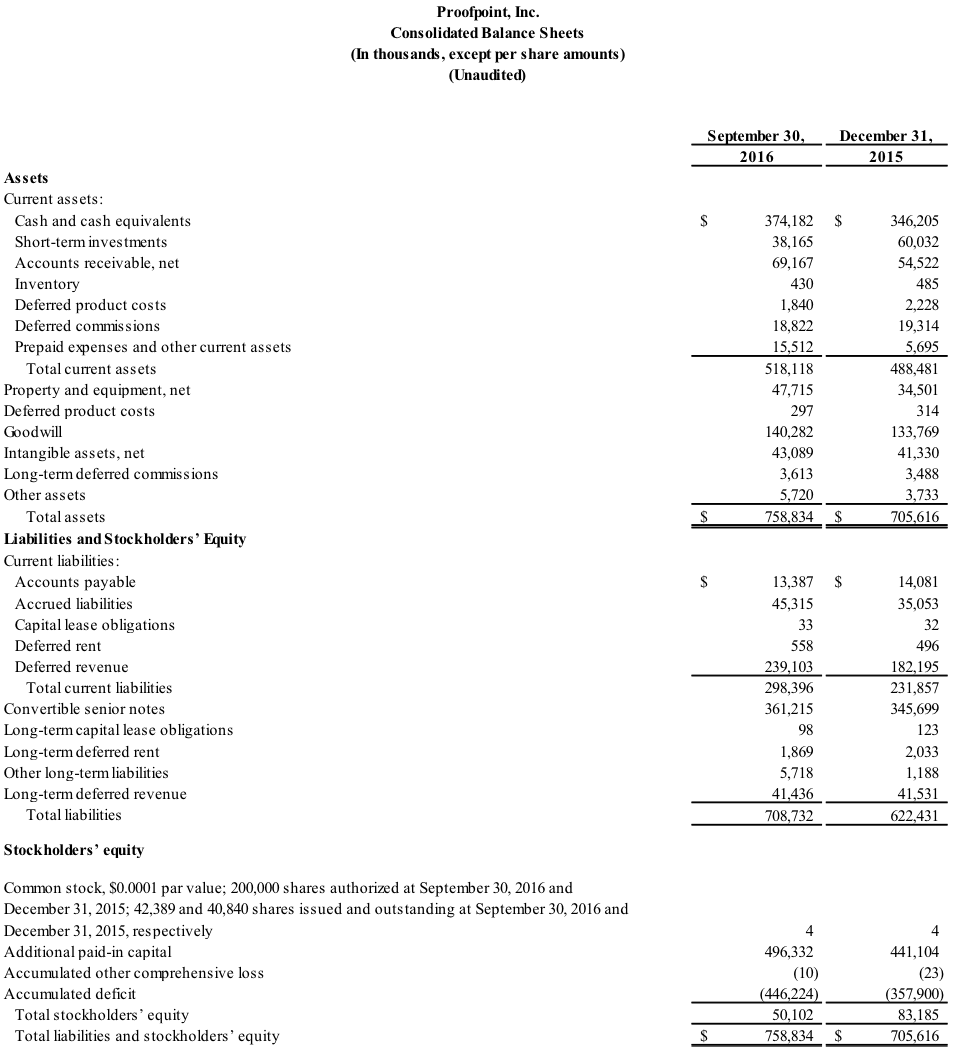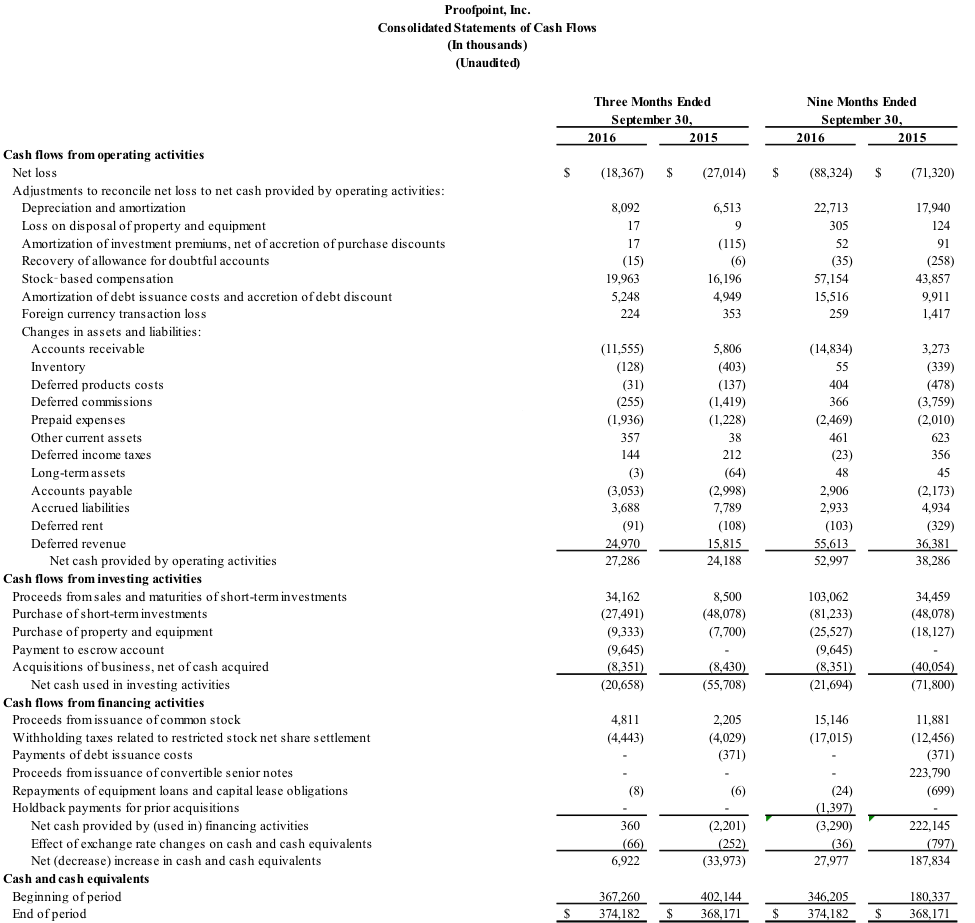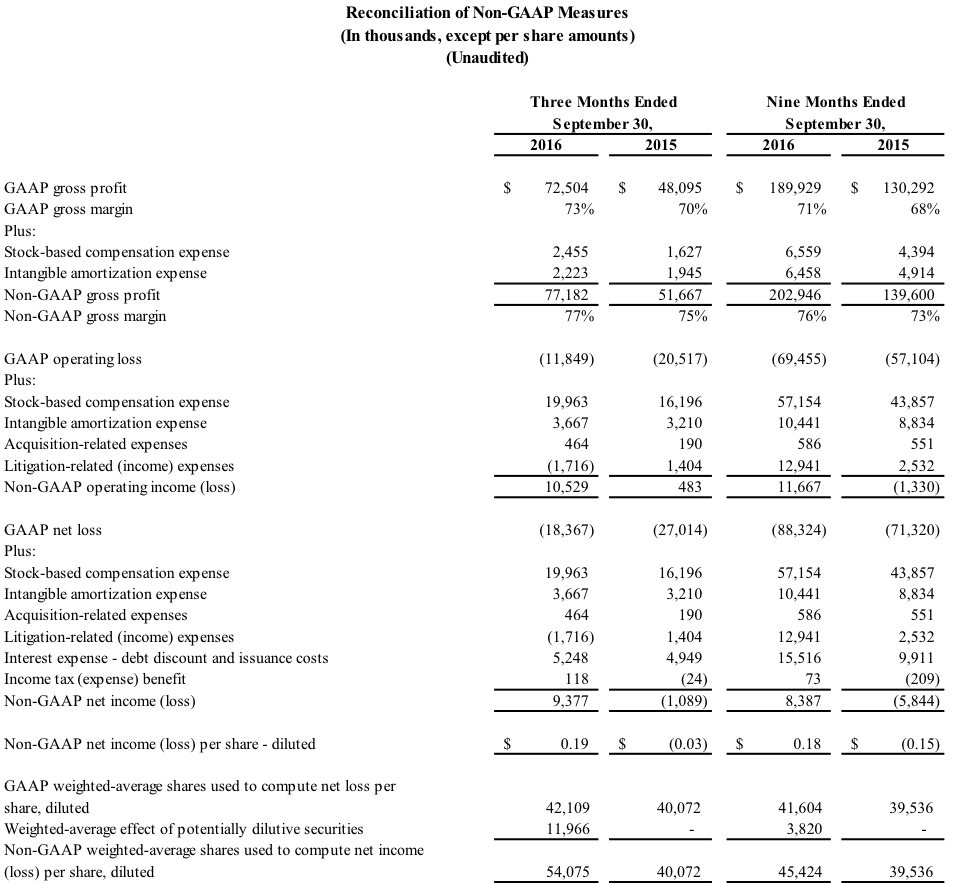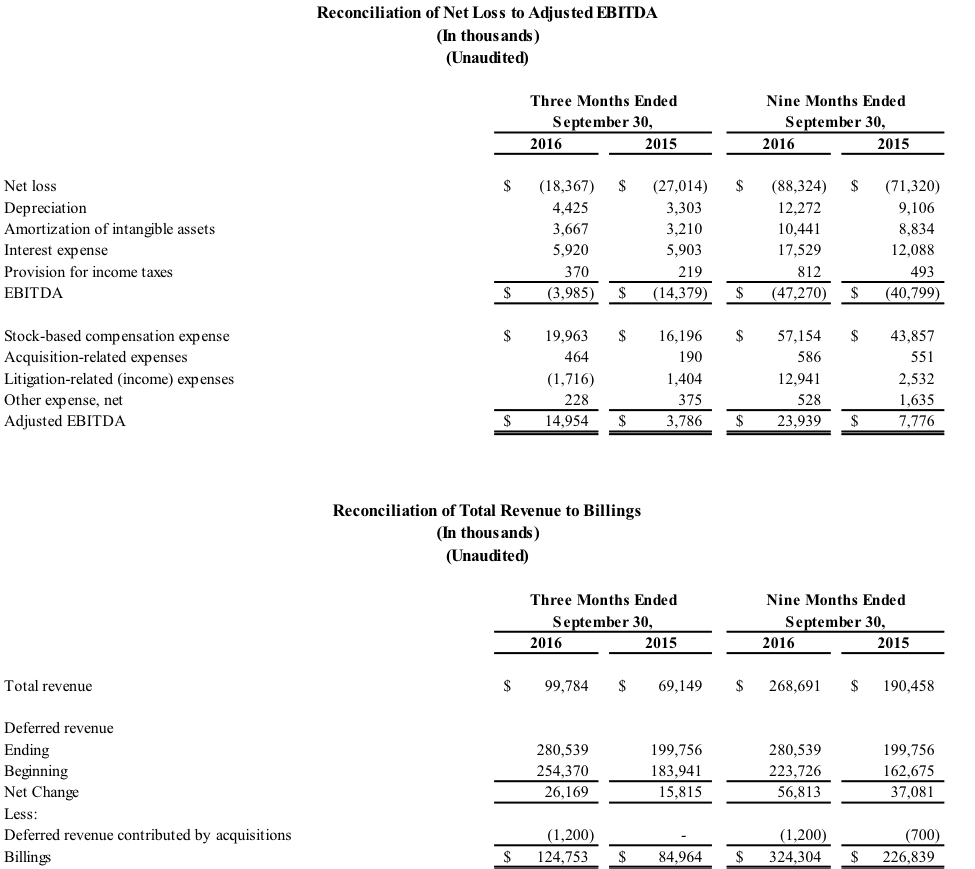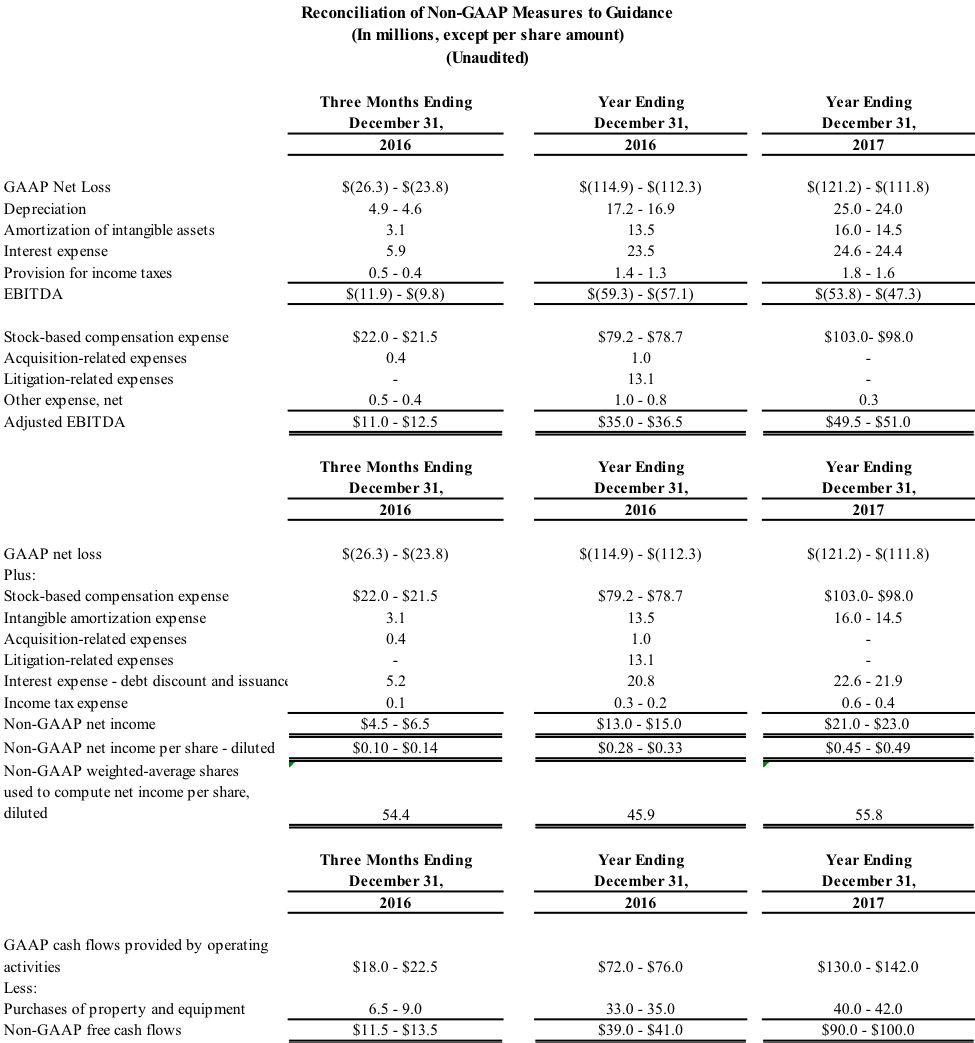Proofpoint Announces Strong Third Quarter 2016 Financial Results

- Total revenue of $99.8 million, up 44% year-over-year
- Billings of $124.8 million, up 47% year-over-year
- GAAP EPS of ($0.44) per share, Non-GAAP EPS of $0.19 per share
- Increasing FY16 billings, revenue, profitability and cash flow guidance
SUNNYVALE, Calif., – October 20, 2016 – Proofpoint, Inc. (NASDAQ: PFPT), a leading next-generation security and compliance company, today announced financial results for the third quarter ended September 30, 2016.
“The third quarter marked another great quarter for the company,” stated Gary Steele, chief executive officer of Proofpoint. “Our ability to exceed expectations across all key metrics was driven by the strong demand for our advanced threat solutions, ongoing high competitive win rates, robust add-on activity, and consistently high renewal rates. The combination of our commitment to innovation, proven ability to enhance the company’s next generation, cloud-based platform through recent acquisitions, and value we are creating with our expanding partner ecosystem, positions Proofpoint to maintain momentum for the remainder of the year and into 2017.”
Third Quarter 2016 Financial Highlights
- Revenue: Total revenue for the third quarter of 2016 was $99.8 million, an increase of 44% compared to $69.1 million for the third quarter of 2015.
- Billings: Total billings were $124.8million for the third quarter of 2016, an increase of 47% compared to $85.0 million for the third quarter of 2015.
- Gross Profit: GAAP gross profit for the third quarter of 2016 was $72.5 million compared to $48.1 million for the third quarter of 2015. Non-GAAP gross profit for the third quarter of 2016 was $77.2 million compared to $51.7 million for the third quarter of 2015. GAAP gross margin for the third quarter of 2016 was 73% compared to 70% for the third quarter of 2015. Non-GAAP gross margin was 77% for the third quarter of 2016 compared to 75% for the third quarter of 2015.
- Operating Income (Loss): GAAP operating loss for the third quarter of 2016 was $11.8 million compared to a loss of $20.5 million for the third quarter of 2015. Non-GAAP operating profit for the third quarter of 2016 was $10.5 million compared to $0.5 million for the third quarter of 2015.
- Net Income (Loss): GAAP net loss for the third quarter of 2016 was $18.4 million, or $0.44 per share, based on 42.1 million weighted average shares outstanding. This compares to a GAAP net loss of $27.0 million, or $0.67 per share, based on 40.1 million weighted average shares outstanding for the third quarter of 2015.
Non-GAAP net profit for the third quarter of 2016 was $9.4 million, or $0.19 per share, based on 54.1 million weighted average diluted shares outstanding. This compares to a non-GAAP net loss of $1.1 million, or $0.03 per share, based on 40.1 million weighted average diluted shares outstanding for the third quarter of 2015.
- Adjusted EBITDA: Adjusted EBITDA for the third quarter of 2016 was $15.0 million compared to $3.8 million for the third quarter of 2015.
- Cash and Cash Flow: As of September 30, 2016, Proofpoint had cash, cash equivalents and short term investments of $412.3 million. The company generated $27.3 million in net cash from operations for the third quarter of 2016 compared to $24.2 million during the third quarter of 2015. The company’s free cash flow for the quarter was $18.0 million compared to $16.5 million for the third quarter of 2015.
“Our strong third quarter results were highlighted by billings and revenue growth of 47% and 44% year-over-year, respectively,” stated Paul Auvil, chief financial officer of Proofpoint. “During the quarter, we were particularly pleased with our ability to exceed our profitability and free cash flow expectations while continuing to gain share globally.”
A reconciliation of GAAP to non-GAAP financial measures has been provided in the financial tables included in this press release. An explanation of these measures and how they are calculated are also included below under the heading “Non-GAAP Financial Measures.”
Third Quarter and Recent Business Highlights:
- Announced entering into a definitive agreement to acquire FireLayers, an innovator in cloud security, which will extend Proofpoint’s Targeted Attack Protection to SaaS applications enabling customers to protect their employees using SaaS applications from advanced malware.
- Proofpoint acquired Return Path's Email Fraud Protection Business Unit, extending its suite of Business Email Compromise (BEC) solutions.
- Proofpoint was named a leader in digital risk monitoring in The Forrester Wave™: Digital Risk Monitoring, Q3 2016 report and was also granted a new patent for its social media protection technology.
Financial Outlook
As of October 20, 2016, Proofpoint is providing guidance for its fourth quarter and increasing full year 2016 guidance as follows:
- Fourth Quarter 2016 Guidance: Total revenue is expected to be in the range of $103.0 million to $105.0 million. Billings are expected to be in the range of $133.5 million to $135.5 million. GAAP EPS loss is expected to be in the range of $0.56 to $0.62 per share based on approximately 42.6 million weighted average diluted shares outstanding. Adjusted EBITDA is expected to be in the range of $11.0 million to $12.5 million. Non-GAAP EPS is expected to be in the range of positive $0.10 to $0.14 per share based on approximately 54.4 million weighted average diluted shares outstanding. Free cash flow is expected to be in the range of $11.5 million to $13.5 million.
- Full Year 2016 Guidance: Total revenue is expected to be in the range of $371.7 million to $373.7 million. Billings are expected to be in the range of $457.8 million to $459.8 million. GAAP EPS loss is expected to be in the range of $2.68 to $2.74 per share based on approximately 41.9 million weighted average diluted shares outstanding. Adjusted EBITDA is expected to be in the range of $35.0 million to $36.5 million. Non-GAAP EPS is expected to be in the range of positive $0.28 to $0.33 per share based on approximately 45.9 million weighted average diluted shares outstanding. Free cash flow is expected to be in the range of $39.0 million to $41.0 million, which assumes capital expenditures of $33.0 million to $35.0 million for the full year.
Quarterly Conference Call
Proofpoint will host a conference call today at 1:30 p.m. Pacific Time (4:30 p.m. Eastern Time) to review the company’s financial results for the third quarter ended September 30, 2016. To access this call, dial (800) 406-5356 for the U.S. or Canada and (913) 312-1422 for international callers with conference ID #3669528. A live webcast of the conference call will be accessible from the Investors section of Proofpoint’s website at investors.proofpoint.com, and a recording will be archived and accessible at investors.proofpoint.com. An audio replay of this conference call will also be available through November 3, 2016, by dialing (877) 870-5176 for the U.S. or Canada or (858) 384-5517 for international callers, and entering passcode #3669528.
About Proofpoint, Inc.
Proofpoint Inc. (NASDAQ:PFPT) is a leading next-generation security and compliance company that provides cloud-based solutions to protect the way people work today. Proofpoint solutions enable organizations to protect their users from advanced attacks delivered via email, social media and mobile apps, protect the information their users create from advanced attacks and compliance risks, and respond quickly when incidents occur. More information is available at www.proofpoint.com.
Connect with Proofpoint: Twitter | LinkedIn | Facebook | YouTube | Google+
Proofpoint is a trademark or registered trademark of Proofpoint, Inc. in the U.S. and other countries. All other trademarks contained herein are the property of their respective owners.
Forward-Looking Statements
This press release contains forward-looking statements that involve risks and uncertainties. These forward-looking statements include statements regarding momentum in the company’s business, market position, win rates and renewal rates, future growth, and future financial results. It is possible that future circumstances might differ from the assumptions on which such statements are based. Important factors that could cause results to differ materially from the statements herein include: failure to maintain or increase renewals and increased business from existing customers and failure to generate increased business through existing or new channel partner relationships; uncertainties related to continued success in sales growth and market share gains; failure to convert sales opportunities into definitive customer agreements; risks associated with successful implementation of multiple integrated software products and other product functionality; competition, particularly from larger companies with more resources than Proofpoint; risks related to new target markets, new product introductions and innovation and market acceptance thereof; the ability to attract and retain key personnel; potential changes in strategy; risks associated with management of growth; lengthy sales and implementation cycles, particularly in larger organizations; the time it takes new sales personnel to become fully productive; unforeseen delays in developing new technologies and the uncertain market acceptance of new products or features; technological changes that make Proofpoint's products and services less competitive; security breaches, which could affect our brand; the costs of litigation; the impact of changes in foreign currency exchange rates; the effect of general economic conditions, including as a result of specific economic risks in different geographies and among different industries; risks related to integrating the employees, customers and technologies of acquired businesses; assumption of unknown liabilities from acquisitions; ability to retain customers of acquired entities; and the other risk factors set forth from time to time in our filings with the SEC, including our Quarterly Report on Form 10-Q for the three months ended June 30, 2016, and the other reports we file with the SEC, copies of which are available free of charge at the SEC's website at www.sec.gov or upon request from our investor relations department. All forward-looking statements herein reflect our opinions only as of the date of this release, and Proofpoint undertakes no obligation, and expressly disclaims any obligation, to update forward-looking statements herein in light of new information or future events.
Non-GAAP Financial Measures
We have provided in this release financial information that has not been prepared in accordance with GAAP. We use these non-GAAP financial measures internally in analyzing our financial results and believe they are useful to investors, as a supplement to GAAP measures, in evaluating our ongoing operational performance. We believe that the use of these non-GAAP financial measures provides an additional tool for investors to use in evaluating ongoing operating results and trends and in comparing our financial results with other companies in our industry, many of which present similar non-GAAP financial measures to investors.
Non-GAAP financial measures should not be considered in isolation from, or as a substitute for, financial information prepared in accordance with GAAP. Investors are encouraged to review the reconciliation of these non-GAAP financial measures to their most directly comparable GAAP financial measures below. As previously mentioned, a reconciliation of our non-GAAP financial measures to their most directly comparable GAAP measures has been provided in the financial statement tables included below in this press release.
Non-GAAP gross profit and gross margin. We define non-GAAP gross profit as GAAP gross profit, adjusted to exclude stock-based compensation expense and the amortization of intangibles associated with acquisitions. We define non-GAAP gross margin as non-GAAP gross profit divided by GAAP revenue. We consider these non-GAAP financial measures to be useful metrics for management and investors because they exclude the effect of non-cash charges that can fluctuate for Proofpoint, based on timing of equity award grants and the size, timing and purchase price allocation of acquisitions so that our management and investors can compare our recurring core business operating results over multiple periods. There are a number of limitations related to the use of non-GAAP gross profit and non-GAAP gross margin versus gross profit and gross margin, in each case, calculated in accordance with GAAP. For example, stock-based compensation has been and will continue to be for the foreseeable future a significant recurring expense in our business. Stock-based compensation is an important part of our employees' compensation and impacts their performance. In addition, the components of the costs that we exclude in our calculation of non-GAAP gross profit and non-GAAP gross margin may differ from the components that our peer companies exclude when they report their non-GAAP results. Management compensates for these limitations by providing specific information regarding the GAAP amounts excluded from non-GAAP gross profit and non-GAAP gross margin and evaluating non-GAAP gross profit and non-GAAP gross margin together with gross profit and gross margin calculated in accordance with GAAP.
Non-GAAP operating loss. We define non-GAAP operating loss as operating loss, adjusted to exclude stock-based compensation expense and the amortization of intangibles and costs associated with acquisitions and litigation. We consider this non-GAAP financial measure to be a useful metric for management and investors because they exclude the effect of stock-based compensation expense and the amortization of intangibles and costs associated with acquisitions and litigation so that our management and investors can compare our recurring core business operating results over multiple periods. There are a number of limitations related to the use of non-GAAP operating loss versus operating loss calculated in accordance with GAAP. For example, as noted above, non-GAAP operating loss excludes stock-based compensation expense. In addition, the components of the costs that we exclude in our calculation of non-GAAP operating loss may differ from the components that our peer companies exclude when they report their non-GAAP results of operations, and many of these items are cash-based. Management compensates for these limitations by providing specific information regarding the GAAP amounts excluded from non-GAAP operating loss and evaluating non-GAAP operating loss together with operating loss calculated in accordance with GAAP.
Non-GAAP net loss. We define non-GAAP net loss as net loss, adjusted to exclude stock-based compensation expense, amortization of intangibles, costs associated with acquisitions and litigation, non-cash interest expense related to the convertible debt discount and issuance costs for the convertible debt offering, and tax effects associated with these items. We consider this non-GAAP financial measure to be a useful metric for management and investors for the same reasons that we use non-GAAP operating loss. However, in order to provide a complete picture of our recurring core business operating results, we also exclude from non-GAAP net loss the tax effects associated with stock-based compensation and the amortization of intangibles and costs associated with acquisitions and litigation, and non-cash interest expense related to the convertible debt discount and issuance costs for the convertible debt offering. We believe that $0.3 million, exclusive of potential discrete items, is a reasonable estimate of the near-term non-GAAP quarterly tax expense under our current global operating structure.
Billings. We define billings as revenue recognized plus the change in deferred revenue from the beginning to the end of the period, but excluding additions to deferred revenue from acquisitions. We consider billings to be a useful metric for management and investors because billings drive deferred revenue, which is an important indicator of the health and visibility of our business, and has historically represented a majority of the quarterly revenue that we recognize. There are a number of limitations related to the use of billings versus revenue calculated in accordance with GAAP. Billings include amounts that have not yet been recognized as revenue, but exclude additions to deferred revenue from acquisitions. We may also calculate billings in a manner that is different from other companies that report similar financial measures. Management compensates for these limitations by providing specific information regarding GAAP revenue and evaluating billings together with revenues calculated in accordance with GAAP.
Adjusted EBITDA. We define adjusted EBITDA as net loss, adjusted to exclude: depreciation, amortization of intangibles, interest income (expense), net, provision for income taxes, stock-based compensation, acquisition- and litigation-related expense, other income (expense), net. We believe that the use of adjusted EBITDA is useful to investors and other users of our financial statements in evaluating our operating performance because it provides them with an additional tool to compare business performance across companies and across periods. We use adjusted EBITDA in conjunction with traditional GAAP operating performance measures as part of our overall assessment of our performance, for planning purposes, including the preparation of our annual operating budget, to evaluate the effectiveness of our business strategies and to communicate with our board of directors concerning our financial performance. We do not place undue reliance on adjusted EBITDA as our only measure of operating performance. Adjusted EBITDA should not be considered as a substitute for other measures of financial performance reported in accordance with GAAP. There are limitations to using this non-GAAP financial measure, including that other companies may calculate this measure differently than we do, that it does not reflect our capital expenditures or future requirements for capital expenditures and that it does not reflect changes in, or cash requirements for, our working capital and excluding some items that are cash based.
Free cash flow. We define free cash flow as net cash provided by operating activities minus capital expenditures. We consider free cash flow to be a liquidity measure that provides useful information to management and investors about the amount of cash generated by the business that, after the acquisition of property and equipment, can be used for strategic opportunities, including investing in our business, making strategic acquisitions, and strengthening the balance sheet. Analysis of free cash flow facilitates management's comparisons of our operating results to competitors' operating results. A limitation of using free cash flow versus the GAAP measure of net cash provided by operating activities as a means for evaluating our company is that free cash flow does not represent the total increase or decrease in the cash balance from operations for the period because it excludes cash used for capital expenditures during the period. Management compensates for this limitation by providing information about our capital expenditures on the face of the cash flow statement and in the "Management's Discussion and Analysis of Financial Condition and Results of Operations - Liquidity and Capital Resources" section of our quarterly and annual reports filed with the SEC.
Media Contact:
Kristy Campbell
Proofpoint, Inc.
408-517-4710
KCAMPBELL@PROOFPOINT.COM
Investor Contact:
Seth Potter
ICR, Inc. for Proofpoint, Inc.
646-277-1230
seth.potter@icrinc.com
